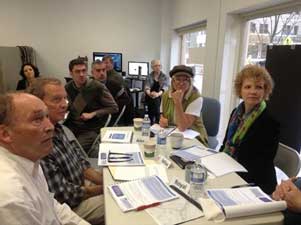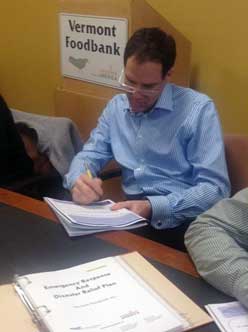Earlier this month, two IBM specialists in business continuity and resiliency services conducted two Disaster Preparedness for Nonprofit Workshops in Vermont. The workshops were donated to the Vermont Digital Economy Project through IBM’s Service Grants program.
I had arranged the first workshop through the leadership of the Vermont Access Network, a professional membership organization representing 26 of Vermont’s AMOs. It was attended by 17 reps from a dozen different PEG television stations — also known as Access Management Organizations (AMOs) — from St. Albans to Bennington and several communities in between. AMOs serve their communities through local programming and technology training.
The second workshop took place at the Vermont Foodbank in Barre. Like the access management organizations, the VFB has to protect its own assets from risk and it needs to be prepared to act quickly in the event of a disaster to help people and communities in need. The VFB’s mission is to “gather and share quality food and nurture partnerships so that no one in Vermont will go hungry” and it does this by distributing food to its network of 270 food shelves throughout the state.
The same two consultants ran the two 4-hour workshops using the same tools and principles. It amazed me how very different the two sessions were.
 The first IBM Disaster Preparedness for Nonprofits Workshop took place at ORCA Media in Montpelier and was attended by 17 representatives from 12 different Community Access Organizations (also commonly known as PEG TV stations).
The first IBM Disaster Preparedness for Nonprofits Workshop took place at ORCA Media in Montpelier and was attended by 17 representatives from 12 different Community Access Organizations (also commonly known as PEG TV stations).At the AMO session, even though several attendees had experienced impacts from Tropical Storm Irene, only one organization came to the workshop with a disaster preparedness plan already in place.
In fact, it took some effort to persuade Alex Maclay, Executive Director of Mad River Valley Television in Waitsfield, to attend the workshop. It wasn’t that she didn’t think disaster planning was important; it was because she is still highly impacted by the damage caused by Tropical Storm Irene and she just wasn’t sure she wanted to relive it. “We were totally flooded out during Irene and we literally lost everything we had except the manuals for our equipment, because they were on the top shelf. I came today, because we want to be able to better serve our community when there is another disaster.”
I was very glad they all took time to attend – and so were they. As noted by Lisa Byer, Executive Director of Catamount Access Television in Bennington and President of Vermont Access Network: “Most of our communities do not have network affiliates, so our communities look to us for information, making it important for us to get back up-and-running quickly after a disaster. I am so very pleased to see so many of our organizations came to this workshop. Before Tropical Storm Irene, I don’t think any of us would have considered coming.”
In leading the workshop, IBM consultants Rod Rahe and Pat Corcoran used a specially prepared workbook on organizational continuity to frame a dialog for the group to discuss their vulnerabilities to all types of risk, including from data, business, or events — everything from a coffee pot shorting out and causing a fire to a competitor making an acquisition in your industry.
Surprisingly, the starting point for making a disaster plan is not about these events, but about the strategy and mission of the organization. Knowing the most important thing you do helps to guide exactly what you need to do in an emergency and what you must protect from risk.
Because the AMOs didn’t have plans already, the conversation was at a higher level. But still extremely helpful to the participants. Through the exercises and conversations, the team agreed that each individual community access group needed to have their own disaster preparedness plan and also that the Vermont Access Network Organization needed to have its own continuity plan.
As Rob Chapman, Executive Director of Onion River Community Access in Montpelier, who was the host of the workshop and President of VAN during Tropical Storm Irene, noted: “If we all had these plans in place, we would have been able to help out Alex and Mad River Television. But we didn’t know she was under water for 3 weeks!”
The team also agreed that there was a unique role their group can play in a disaster situation, because of their status as highly localized media outlets. Lisa Byer said, “We must partner with local municipalities, fire departments, and others, so that we can participate in the response itself. We should be included in their community plan. We need to have a plan in advance and be seen as an asset and part of community emergency planning.”
 The second IBM Disaster Preparedness for Nonprofits Workshop took place at the Vermont Foodbank (VFB) in Barre and was attended by VFB CEO Jon Sayles and his entire leadership team. After Tropical Storm Irene, VFB created an Emergency Response & Disaster Relief Plan. The team got expert IBM advice on how to improve and expand the plan.
The second IBM Disaster Preparedness for Nonprofits Workshop took place at the Vermont Foodbank (VFB) in Barre and was attended by VFB CEO Jon Sayles and his entire leadership team. After Tropical Storm Irene, VFB created an Emergency Response & Disaster Relief Plan. The team got expert IBM advice on how to improve and expand the plan.In the case of the second workshop, the day started with high praise from Pat Corcoran, an IBM Global Business Development Executive and founder of IBM’s Business Continuity & Resiliency Services Group, for the Vermont Foodbank executive team: “This is the first time I have come to a nonprofit that has a plan like you do at the Vermont Foodbank.”
Jon Sayles, the CEO of Vermont Foodbank explained his commitment to disaster planning this way: “It is extremely worthwhile for our leadership team to spend four hours going through in detail and socializing our business continuity plan, so that we can make it better.”
Unlike with the AMOs, because they already had a working plan, the VFB team was able to go into deep detail about the pros and cons of their existing plan and gain great insight on other elements to consider. Among the many things the team took out of the workshop were to add the organizational mission and priorities to the existing plan and to make sure to review it every six months and update it every year to ensure that it is always current and relevant.
Additionally, as noted by Francine Chittenden, VFB’s Chief Operations Officer: “After Irene, we realized that we had to put more emphasis on our people. There was a lot of stress on our staff, trying to meet the increased demand for our services.”
The organizations who attended each workshop received a lot of value from the sessions. Although each workshop had a distinct feel, one thing that was very clear from both of these workshops is that you have to start by thinking through your mission and then document your plan. And, once you have a plan, it is never really finished. It can always be tested and improved.
